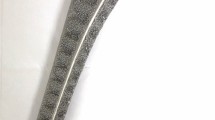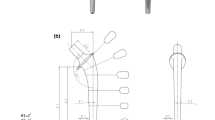Abstract
Introduction
The aim of this study was to compare the influence of two different cemented hip stems each made of two different alloys concerning survival and outcome.
Materials and methods
The 5-year results with 161 Mueller straight stems made of cobalt chromium (SS CoCr), 272 Mueller straight stems made of titanium (SS Ti), 233 Mueller SL stems made of titanium (SL Ti) and 255 SL stems made of cobalt chromium (SL CoCr) implanted consecutively in this order were compared. All patients were followed up prospectively during the first 5 years after implantation. The evaluation of the results was retrospective.
Results
The survival rates for aseptic loosening were 100% (SS CoCr), 92.8% (SS Ti), 81.6% (SL Ti) and 97.8% (SL CoCr). Clinical and radiological outcomes like pain occurrence, use of pain medication, ability to climb stairs, amount of stem subsidence and osteolysis correlated statistically significantly with the results of the survival rates. Concerning the two alloys, chromium cobalt showed better results, and concerning the two designs, the straight stem had a better outcome. For the four prostheses being compared, the results were influenced more by the alloy than by the design, and the small-sized titanium stems were more susceptible to undergoing revision than the large-sized prostheses.
Conclusion
Stem design and even more alloy may influence the survival rate and clinical outcome. Evaluating the results, we recommend the use of the classic straight stem prosthesis made of cobalt chromium.


Similar content being viewed by others
References
Acklin YP, Berli BJ, Frick W, Elke R, Morscher EW (2001) Nine-year results of Muller cemented titanium straight stems in total hip replacement. Arch Orthop Trauma Surg 121:391–398
Barrack RL, Folgueras AJ (1995) Revision total hip arthroplasty: the femoral component. J Am Acad Orthop Surg 3:79–85
Bowditch M, Villar R (2001) Is titanium so bad? Medium-term outcome of cemented titanium stems. J Bone Joint Surg Br 83:680–685
Collis DK, Mohler CG (2002) Comparison of clinical outcomes in total hip arthroplasty using rough and polished cemented stems with essentially the same geometry. J Bone Joint Surg Am 84:586–592
Ebramzadeh E, Sarmiento A, McKellop HA, Llinas A, Gogan W (1994) The cement mantle in total hip arthroplasty. Analysis of long-term radiographic results. J Bone Joint Surg Am 76:77–87
Ebramzadeh E, Normand PL, Sangiorgio SN, Llinas A, Gruen TA, McKellop HA, Sarmiento A (2003) Long-term radiographic changes in cemented total hip arthroplasty with six designs of femoral components. Biomaterials 24:3351–3363
Eggli S, Holm J (2001) Implementation of a new electronic patient record in surgery (in German). Chirurg 72:1492–1500
Eingartner C, Volkmann R, Kummel K, Weller S (1997) Low loosening rate of a cemented titanium straight shaft prosthesis in long-term follow-up (in German). Swiss Surg 3:49–54
Eingartner C, Volkmann R, Winter E, Maurer F, Ihm A, Weller S, Weise K (2001) Results of a cemented titanium alloy straight femoral shaft prosthesis after 10 years of follow-up. Int Orthop 25:81–84
Eingartner C, Ihm A, Maurer F, Volkmann R, Weise K, Weller S (2002) Good long term results with a cemented straight femoral shaft prosthesis made of titanium (in German). Unfallchirurg 105:804–810
Gruen TA, McNeice GM, Amstutz HC (1979) ‘Modes of failure’ of cemented stem-type femoral components: a radiographic analysis of loosening. Clin Orthop 141:17–27
Harrington MA Jr, O’Connor DO, Lozynsky AJ, Kovach I, Harris WH (2002) Effects of femoral neck length, stem size, and body weight on strains in the proximal cement mantle. J Bone Joint Surg Am 84:573–579
Hinrichs F, Boudriot U, Griss P (2000) 10 year results with a cemented fine-grit-blasted titanium-aluminum- vanadium hip endoprosthesis shaft (in German). Z Orthop 138:52–56
Jergesen HE, Karlen JW (2002) Clinical outcome in total hip arthroplasty using a cemented titanium femoral prosthesis. J Arthroplasty 17:592–599
Kalairajah Y, Molloy S, Patterson M (2002) The effect of femoral stem size on failure rates in total hip replacement cemented with Boneloc. Acta Orthop Belg 68:33–36
Lennon AB, McCormack BA, Prendergast PJ (2003) The relationship between cement fatigue damage and implant surface finish in proximal femoral prostheses. Med Eng Phys 25:833–841
Lichtinger TK, Schurmann N, Muller RT (2000) Early loosening of a cemented hip endoprosthesis stem of titanium (in German). Unfallchirurg 103:956–960
Malchau H, Herberts P, Soderman P, Oden A (2000) Prognosis of total hip replacement. Results from the Swedish National Hip Arthroplasty Register. Scientific Exhibition, 67th AAOS Meeting, March 15–19, Orlando, USA
Massoud SN, Hunter JB, Holdsworth BJ, Wallace WA, Juliusson R (1997) Early femoral loosening in one design of cemented hip replacement. J Bone Joint Surg Br 79:603–608
Maurer TB, Ochsner PE, Schwarzer G, Schumacher M (2001) Increased loosening of cemented straight stem prostheses made from titanium alloys. An analysis and comparison with prostheses made of cobalt-chromium-nickel alloy. Int Orthop 25:77–80
Meek RM, Michos J, Grigoris P, Hamblen DL (2002) Mid-term results and migration behaviour of a Ti-alloy cemented stem. Int Orthop 26:356–360
Osorovitz P, Goutallier D (1994) Clinical and radiographic results of a continuous series of 124 type Ceraver-Osteal hip prostheses with a 9-year survival analysis (in French). Rev Chir Orthop Reparatrice Appar Mot 80:305–315
Paterson D (1993) The International Documentation and Evaluation System (IDES). Orthopedics 16:11–14
Rader CP, Hendrich C, Low S, Walther M, Eulert J (2000) 5- to 8-year results of total hip endoprosthesis implantation with the Muller straight shaft prosthesis (cemented TiAlNb shaft) (in German). Unfallchirurg 103:846–852
Robinson RP, Lovell TP, Green TM, Bailey GA (1989) Early femoral component loosening in DF-80 total hip arthroplasty. J Arthroplasty 4:55–64
Roder C, Eggli S, Muller U, Ambrose T, Roosli E, Busato A, Aebi M (2003) The International Documentation and Evaluation System (IDES)--10-years experience. Int Orthop 27:259–261
Sarmiento A, Gruen TA (1985) Radiographic analysis of a low-modulus titanium-alloy femoral total hip component. Two to six-year follow-up. J Bone Joint Surg Am 67:48–56
Scholl E, Eggli S, Ganz R (2000) Osteolysis in cemented titanium alloy hip prosthesis. J Arthroplasty 15:570–575
Star MJ, Colwell CW Jr, Kelman GJ, Ballock RT, Walker RH (1994) Suboptimal (thin) distal cement mantle thickness as a contributory factor in total hip arthroplasty femoral component failure. A retrospective radiographic analysis favoring distal stem centralization. J Arthroplasty 9:143–149
Tompkins GS, Lachiewicz PF, DeMasi R (1994) A prospective study of a titanium femoral component for cemented total hip arthroplasty. J Arthroplasty 9:623–630
Author information
Authors and Affiliations
Corresponding author
Rights and permissions
About this article
Cite this article
Schweizer, A., Lüem, M., Riede, U. et al. Five-year results of two cemented hip stem models each made of two different alloys. Arch Orthop Trauma Surg 125, 80–86 (2005). https://doi.org/10.1007/s00402-004-0772-4
Received:
Published:
Issue Date:
DOI: https://doi.org/10.1007/s00402-004-0772-4




